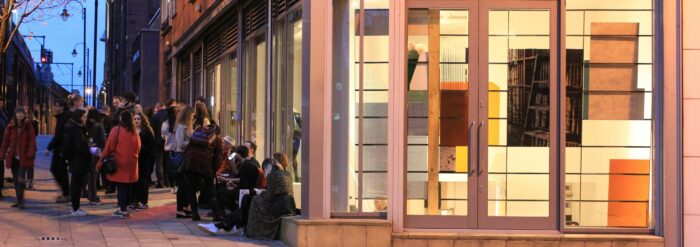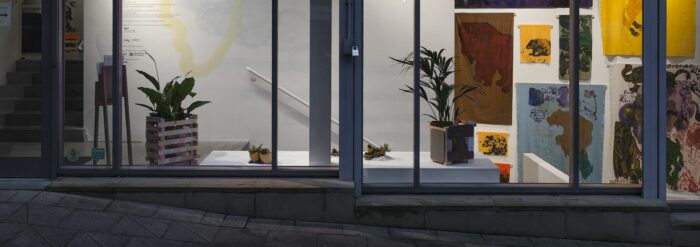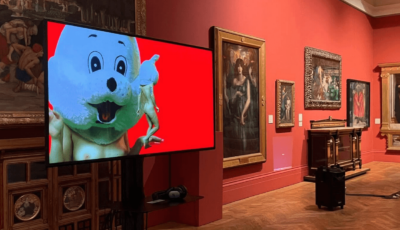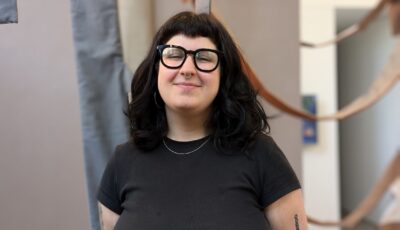Spotlight: Artists and Sustainability – Emily Speed
Posted on 20 March 2024
This month we’ve invited Emily Speed to contribute to our ongoing series Spotlight – Artists and Sustainability, where we ask artists to share short responses about their work and how it might relate to climate change.
Known for her work examining the relationship between the body and architecture, Speed’s practice considers how a person is shaped by the buildings they have occupied and how a person occupies their own psychological space. Working in sculpture, performance, drawing and film, Speed’s work looks at the relationship between people and buildings and in particular the power dynamics at play in built space. Her work plays with scale and creates layers around the body, often hybrid forms of clothing and architecture.
In 2023, Emily Speed was awarded the second of two artist residencies at Energy House 2.0 by The University of Salford Art Collection, in partnership with Castlefield Gallery. She joined artist Mishka Henner, who was announced as the first artist-in-residence at the University’s world-leading research facility, with the University of Salford Art Collection in partnership with Open Eye Gallery. Both are now working closely with the Energy House team to develop new work in response to the groundbreaking research being carried out, around topics of energy efficiency, the climate crisis, net zero research, and the future of housing and homes.
In what ways do you feel your work might relate to issues of climate change and sustainability, in the content of the work, its narrative, conceptually or theoretically. How might it speak to or challenge public discourse?
My work for the last 20 years has been about the body and architecture or built space, with a more recent focus on the power dynamics inherent within those places. Inevitably, when doing any kind of work or thinking connected to architecture and construction, it is impossible not to think about sustainability. I’m currently working on a residency at Energy House 2.0 at the University of Salford, which is looking to work towards net zero housing, so that’s a very direct link and the first time I have been working alongside scientists. I’m really interested in the materials side of their work at Energy House 2.0, but also in thinking about how communities and family units might need to adapt different living conditions with climate change. I am aware that we often accept the conditions we find ourselves in, or get used to them quickly, so I want to remind myself, and others, that alternatives are possible.
With regards the materials, processes, and techniques you use to produce your work, are there any practical decisions you make with regards climate change and sustainability?
Historically, I have worked with a lot of found and recycled materials (like a lot of artists starting out, this was largely due to having no money) and I have always had a complicated relationship with waste and stuff. Over the last ten years or more, the choices I’ve made have been more purposeful and after making Innards (a fountain) in 2017, which had to be skipped as I couldn’t store it, was both a sad and horrifying moment because there were so many resources tied up in that object – I didn’t want to be in that situation again. So, one example of how I have adapted things, was designing the structure for Flatland at Tate Liverpool (made by Kunstruct) to be flat packed and to fit through doors so I could store it and show it again without transport being too ridiculous. The fabric was sourced from my village’s facebook group – old bedding that I dyed in my bath. I do buy new fabric too, but I am careful where I buy it from and look for reliable schemes, such as BCI Cotton. Since 2019 I have been learning to build with cob and to use lime plaster and recent sculptures have combined this plaster work with textile pieces. I am making smaller works but also thinking about how to make things that are possible to use and inhabit in a more practical way.
In general, how do you feel galleries, art spaces, artworks and artists, might be able to contribute, what if any role do you feel they can play in a progressive conversation?
The way the art world travels seems particularly unsustainable, both the people and the artworks, but the art world is so tied up in capitalist systems and luxury is obviously embedded in that, so it seems unlikely that this will change. I have spent most of my artistic life within artist-led spaces and communities and I just think that so many are excellent models of using local networks, resources, and skills and often this is deeply tied into the class system. There is a difficulty in that it’s so hard for many artists to make even close to an average wage in this mode of working, so energy goes into surviving and reacting rather than being able to plan long term. If arts organisations can shift from short term projects with fees that often do not compensate artists for the time they work on them, to longer term work with salary-equivalent pay, there is so much knowledge and power to be harnessed there. I was lucky to spend time working with Susan Jones during my time with a-n and the depth of her research around working conditions for artists is astonishing, I would start there.
Are there any tips or advice, anything you have learnt you might want to share with other artists or our audiences?
The art world feels like an increasingly difficult place to be in, so I think integrity is really the main thing to keep central to your own practice. Jo Lathwood made a manifesto for making sustainable artwork in 2020 and I have been borrowing that – it’s pinned up in my studio, her exhibition, Making Up, at the Lowry explored this in more depth with a circular life of the materials in the work. On an individual level, knowing your own values and creating boundaries around that is perhaps the most immediate thing one can do. I can be astute in giving advice but terrible at doing that for myself so I would also recommend having a critical friend, a support network (irl or online) of other artists. Have artists on boards of directors, invite artists to be consultants, advisors and long-term collaborators.





